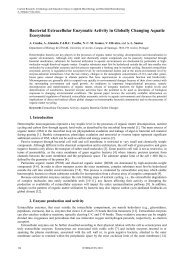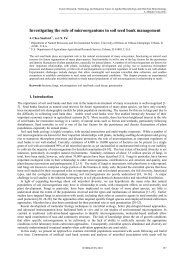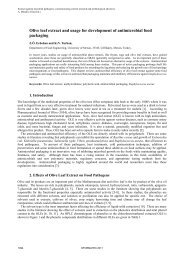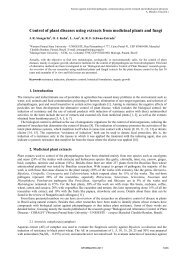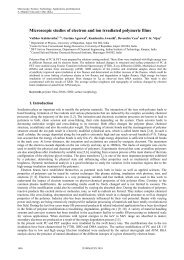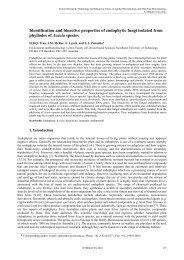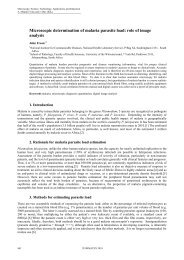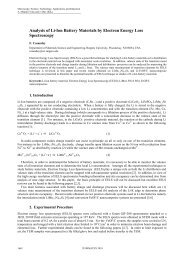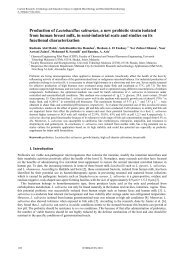Disposable electrochemical biosensors in microbiology - Formatex ...
Disposable electrochemical biosensors in microbiology - Formatex ...
Disposable electrochemical biosensors in microbiology - Formatex ...
Create successful ePaper yourself
Turn your PDF publications into a flip-book with our unique Google optimized e-Paper software.
_______________________________________________________________________________________<br />
Fig. 2 Scheme of a screen<br />
Sealed-mesh Open-mesh<br />
Metal frame<br />
The screen-pr<strong>in</strong>t<strong>in</strong>g <strong>in</strong>k is then poured onto the top surface of the stencil. Then, a squeegee slowly moves from the<br />
rear to the front part of the screen, forc<strong>in</strong>g the <strong>in</strong>k through the open areas. The required pattern is thus deposited onto<br />
the substrate surface, as it can be seen <strong>in</strong> Fig. 3 [14].<br />
Screen<br />
(a) (b) (c)<br />
Substrate<br />
Squeege<br />
Ink<br />
Screen-pr<strong>in</strong>t<strong>in</strong>g<br />
step<br />
Pr<strong>in</strong>ted device<br />
Fig. 3 Screen-pr<strong>in</strong>ted device fabrication process scheme: (a) Ink poured; (b) Squeegee travers<strong>in</strong>g; (c) Ink deposited on<br />
the substrate surface<br />
The next phase of the process is to dry the pr<strong>in</strong>ted <strong>in</strong>k. Screen-pr<strong>in</strong>t<strong>in</strong>g <strong>in</strong>ks usually conta<strong>in</strong> various organic solvents,<br />
which are added with the aim of produc<strong>in</strong>g the accurate viscosity for screen pr<strong>in</strong>t<strong>in</strong>g. These solvents can be removed by<br />
dry<strong>in</strong>g the pr<strong>in</strong>ted <strong>in</strong>k <strong>in</strong> an oven at an adequate temperature. After dry<strong>in</strong>g, the substrate reta<strong>in</strong>s a rigid pattern that is<br />
relatively immune to smudg<strong>in</strong>g [14]. The comb<strong>in</strong>ation of different screens and <strong>in</strong>ks give rise to the def<strong>in</strong>ition of the<br />
different electrodes (work<strong>in</strong>g, reference and auxiliary) <strong>in</strong> the same configuration unit.<br />
F<strong>in</strong>ally, the disposable <strong>electrochemical</strong> biosensor is generated by the subsequent modification of the work<strong>in</strong>g<br />
electrode with the biosens<strong>in</strong>g material. This modification implies several steps <strong>in</strong> order to assure the robustness and<br />
durability of the developed biosensor.<br />
<strong>Disposable</strong> <strong>biosensors</strong> generated by modification of SPEs have been successfully applied <strong>in</strong> the <strong>microbiology</strong> field.<br />
The next section <strong>in</strong>volves the report of different disposable <strong>biosensors</strong> employed <strong>in</strong> such field, <strong>in</strong>clud<strong>in</strong>g the description<br />
of the different biocomponents and immobilization procedures used <strong>in</strong> their development.<br />
3. Screen-pr<strong>in</strong>ted electrodes <strong>biosensors</strong> <strong>in</strong> <strong>microbiology</strong><br />
As it has been mentioned, there is a great number of works describ<strong>in</strong>g the utilization of screen-pr<strong>in</strong>ted <strong>biosensors</strong> <strong>in</strong><br />
microbiological applications. These disposable <strong>biosensors</strong> have been developed by means of the immobilization of<br />
different nature biological elements. The immobilization procedure not only facilitates the required close proximity<br />
between the biomaterial and the transducer, but also helps <strong>in</strong> stabiliz<strong>in</strong>g it for reuse [11]. Thus, immobilization<br />
technology plays a very important role, be<strong>in</strong>g the critical step <strong>in</strong> <strong>biosensors</strong> manufactur<strong>in</strong>g. Many different procedures<br />
have been thus reported for the biological material immobilization conditions onto SPEs.<br />
A brief description of the different biological elements of the diverse immobilization procedures used <strong>in</strong> the<br />
development of disposable <strong>biosensors</strong> has been <strong>in</strong>cluded <strong>in</strong> the follow<strong>in</strong>g sections. This description has been focused <strong>in</strong><br />
the applications of this k<strong>in</strong>d of sensors with<strong>in</strong> <strong>microbiology</strong> field.<br />
3.1. Biological Element<br />
SPEs <strong>biosensors</strong> for detect<strong>in</strong>g microorganisms are mostly based on the <strong>in</strong>teraction between microorganisms and<br />
biological recognition elements such as antibodies giv<strong>in</strong>g rise to very sensitive and selective disposable immunosensors.<br />
The fabrication of DNA <strong>electrochemical</strong> sensors has also attracted a considerable recent attention <strong>in</strong> the development of




